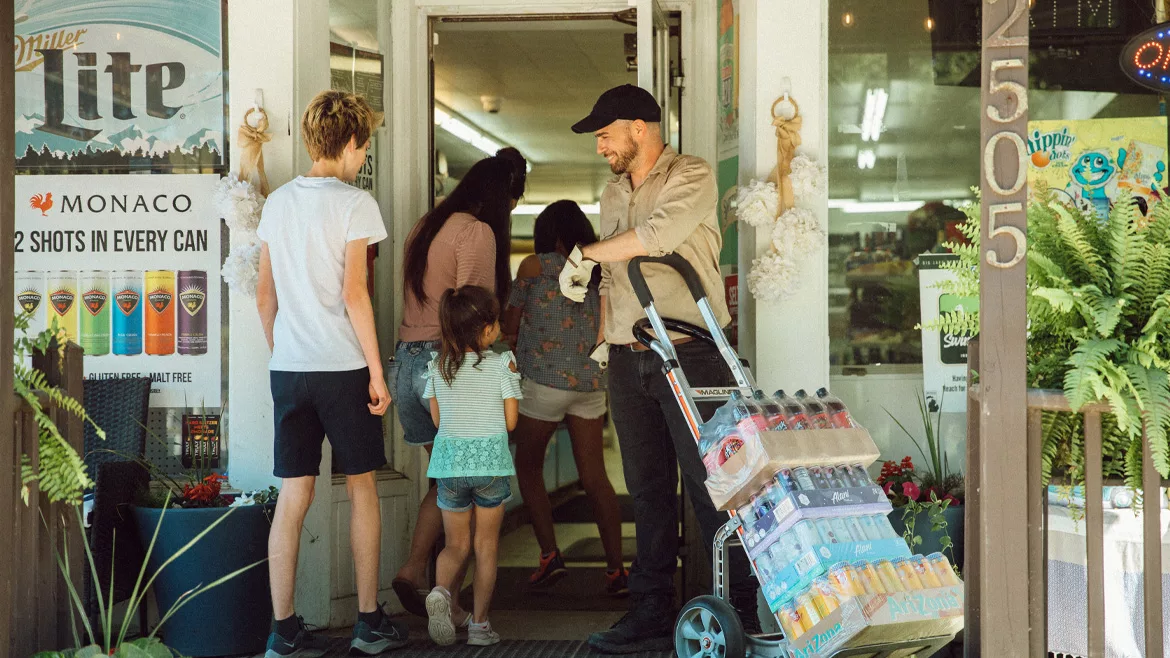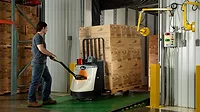Distribution
Carts and hand trucks ensure efficient delivery
Comfortability and movement key factors for delivery personnel

Image courtesy of Magline, Inc.
In the 2001 romantic comedy, “Legally Blonde,” Reese Witherspoon’s Elle Woods befriends manicurist Paulette, played by Jennifer Coolidge. Paulette expresses to Elle that she has a crush on the UPS delivery man, but she is too clumsy and awkward to act on her feelings. Elle teaches Paulette a maneuver called the “bend and snap” to get the delivery man’s attention next time he drops off a package to the salon. Despite accidentally breaking his nose during the “bend and snap,” Paulette and the delivery man end up getting married.
Although most deliveries don’t result in marriage, nevertheless, delivery personnel play a crucial role in distribution within the beverage industry. With growing demands placed on beverage distribution, experts note that increasing challenges, coupled with high consumer expectation has created some concerns among delivery personnel.
Chad Kritzman product manager for pallet trucks at Greene, N.Y.-based The Raymond Corp., notes that these heightened consumer expectations place emphasis on delivery speed, accuracy and effectiveness.
“Previously, buyers would find themselves at numerous stores to look for different products,” he says. “But now with many distribution companies across the country, consumers can find what they want at one location, like a grocery store or gas station. Because of this, it is ever so important for operations to maximize and streamline the distribution and delivery process.”
Kritzman notes that the last-mile delivery process is the most expensive part of the delivery and requires the most amount of labor, which is why it’s important “to have the correct tools to get the job done efficiently and accurately,” from start to finish.
“Delivery personnel are concerned about having a durable and maneuverable pallet truck to consistently deliver product to retail locations,” he says. “A durable pallet truck can withstand the high-throughput applications and the environment. Maneuverability in tight stockrooms and the ability to opportunity charge ensure operation through the entire delivery route.”
Mark Koffarnus, director of major accounts at Greenville, N.C.-based Yale Lift Truck Technologies, also stresses the impact of delivery environments, and considers direct-to-store delivery to be “a labor-intensive format” for beverage delivery personnel.
“They face a landscape that can resemble an obstacle course during almost every shift, with narrow lift gates, uneven terrain, congested store entrances, storerooms, coolers and more,” he explains. “Delivery personnel also face longer routes with more stops as retailers request more frequent, smaller-quantity deliveries to satisfy consumer demand for greater product selection.”
For Koffarnus, he believes that the biggest concerns in beverage distribution are associated to labor, ergonomics, and safety and efficiency challenges.
Brenden Vieau, digital marketing specialist at Standish, Mich.-based Magline Inc., shares similar viewpoints when it comes to beverage distribution considerations.
“Delivery personnel face many types of businesses and environments along their daily route,” he says. “Each delivery location can feature different obstacles such as stairs, inclines or long distances. These obstacles increase the likelihood of injury, which may require drivers to take time off from work.”
The retention of delivery drivers because of increased risk of injury and required labor for these roles are very significant concerns. Additionally, the rising cost of equipment and operations is impacting delivery.

Image courtesy of The Raymond Corp
Steering toward solutions
Carts and hand trucks can offer solutions to the above concerns.
Yale’s Koffarnus says it all starts with improving the work experience, considering it to be vital.
“Beverage operations should ensure pallet trucks possess strong maneuverability, stability and battery life,” he explains. “For example, an ergonomic handle design allows for easier maneuverability in stores and on lift gates by allowing the operator to stand beside the truck with on-hand throttle activation and full visibility of the truck from end-to-end. Other features, like a load retention strap, can also help with stability when moving loads over rough terrain, like poorly paved parking lots.”
Koffarnus notes that lithium-ion battery power can allow for longer runtimes and opportunity charging, and thus powering through longer delivery routes. These batteries, unlike lead-acid alternatives, can be charged in the trailer between deliveries and eliminating the need for battery replacement, he explains.
Magline’s Vieau explains that carts and hand trucks “greatly decrease injury risk to drivers,” because they reduce the amount of trips needed to complete deliveries. This is “especially important” when it comes to overcoming obstacles, he says.
“Drivers appreciate when companies make their jobs easier by providing quality, lightweight and reliable delivery equipment,” Vieau says. “This can lead to higher job satisfaction.”
Along with quality equipment, Vieau adds that modular hand trucks with replaceable parts last longer. This saves the company costs over times, because the carts can be repaired with an easy replacement or simple hand tools.
The Raymond Corp.’s Kritzman considers pallet trucks to be “a primary piece of equipment” that can aid operators with their delivery, order picking and horizontal transport needs in a variety of venues.
“They provide much-needed maneuverability in tight spaces, such as the back of trailers in transport and store stockrooms to load and unload product,” he says. “Ride-on pallet trucks are also a cost-effective option in long, horizontal travel situations, such as putaways.”
Kritzman notes that pallet trucks offer sustainable energy sources and, like Vieau mentioned, allow for opportunity charging and fewer battery changes.
“Pallet trucks that have durable undercarriages and IP65-rated electronics to withstand heavy usage and the environment,” he says. “Deliver personnel often deliver to locations without a loading dock. Standard features, such as Click2Creep, allow for precise maneuverability while the electronic keypad prevents unauthorized usage.”

Image courtesy of Yale Lift Truck Technologies
There are additional benefits to using carts and hand trucks.
Yale’s Koffarnus says that, because of present labor challenges, inexperienced workers and operators are becoming more and more common. These inexperienced workers must navigate and maneuver through challenging spaces, which can not only slow down productivity, but also lead to accidents, he points out.
“Given these conditions, compact and efficient pallet trucks are especially vital,” he expresses. “Yale Smart Slow Down technology reduces truck speed when it senses a change in direction to assist the operator with load stability through corners. The feature is available on the Yale MPB-VG walkie pallet truck, which also offers a direct store delivery handle design to help give delivery personnel greater peace of mind and boost productivity.”
Koffarnus explains that the handle provides users with “full control in the upright position for maneuverability and visibility inside a trailer or between aisles.” The handle also allows the driver to operate and stand next to the truck securely, with complete visibility of the end of the lift gate, he says.
Further, Koffarnus stresses the importance of ergonomic features, which keep operators “comfortable, satisfied and productive.”
“For example, a shorter, mid-mounted handle moves the operator closer to the truck, helping maximize both visibility and maneuverability,” Koffarnus says. “A light hold-down effort for the steering tiller requires little exertion by the operator to move the handle to the run zone and maintain its position.”
He adds that truck-mounted lights are an effective feature for visibility and awareness, both for the operator and for pedestrians.
Magline’s Vieau notes that customizable carts can offer additional benefits. Equipment that is made specifically for the needs of the drivers and their routes will ensure ease of delivery, he says. As an example, he explains how a cart with bolt-on, stair climbing glides would make a route with lots of stairs less demanding for the delivery personnel.
Vieau considers stairs to be one of the biggest setbacks for beverage delivery personnel, and the hand truck market continues to make innovations in reducing this risk.
“Beverage companies can further reduce injury risk to their drivers further by selecting lightweight, yet strong, aluminum hand trucks,” Vieau says. “When compared to a heavier steel cart, the reduced weight of an aluminum hand truck greatly reduces the daily strain on a beverage delivery driver.”
Transforming the force
Aside from increased consumer demand, other impacts from beverage industry is affecting the carts and hand trucks market.
However, consumers aren’t just demanding more of certain products. They are demanding more variety and selection of products.
Yale’s Koffarnus notes that this affects delivery personnel because they must deal with a growing number of products and SKUs, an uptick in deliveries, as well as tightened delivery timeframes.
“SKU proliferation also continues to be a transformative force, not just in the beverage industry, but across distribution operations,” he says. “As customers clamor for more product options, SKU counts continue to escalate, increasing the need for more racking in facilities already short on space and risking an increase in congested pick paths and cluttered aisles that can slow down productivity.”
Going forward, Koffarnus says that operator productivity, safety and comfort will be critical, because of how physically demanding personnel positions are in beverage warehouse and distribution environments.
“Ergonomic developments are increasingly important, and technology-driven features are also helping to support a more optimal work experience,” he notes. “For instance, product design is evolving to help keep operators fresh and focused.”
The Raymond Corp.’s Kritzman also says that pallet trucks are ever-increasingly being designed with the operator in mind.
“We’re also seeing the integration of technology to help improve order picking productivity, such as operator assist technologies, into the pallet truck itself,” he explains. “These new technologies help support efficient operation and reinforce operator best practices. Solutions such as operator assist technologies and cutting-edge order picking can be a great way to optimize operations and maximize labor while improving the operator experience.”
He adds that such technologies can be added to the base layer of a lift truck, which creates integrated systems “that can increase operator proficiency, accuracy and productivity,” especially as companies aim to meet consumer demand.
Looking for a reprint of this article?
From high-res PDFs to custom plaques, order your copy today!




